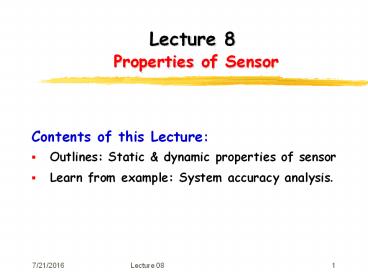Lecture 8 Properties of Sensor PowerPoint PPT Presentation
1 / 32
Title: Lecture 8 Properties of Sensor
1
Lecture 8 Properties of Sensor
- Contents of this Lecture
- Outlines Static dynamic properties of sensor
- Learn from example System accuracy analysis.
2
Static Characteristics of Sensors
The ways in which a sensor affects the
measurement performance due to the feature of the
sensor are termed its static characteristics.
3
Input and Out Range
- Input Range
- the interval between the maximum and minimum
admissible input range Imax, Imin - Output Range
- the interval between the maximum and minimum
reachable output range - Omax, Omin
4
Span and Zero
- Zero the system output corresponding to a zero
input.
5
Accuracy Error Bands
- Error Bands h
- manufacturer defined performance values
- Error bands is an indication of accuracy in
terms of a statistical density function.
6
Resolution
- Resolution is the smallest detectable incremental
change of input that can be detected in output
signal. - For any devices, their resolution is fixed.
7
Sensitivity Gain
- Sensitivity (Gain) is the rate of change in
output corresponding to the rate of change in
input dO/dI. - At different range, the sensitivity may be
different a device
dO
dI
8
Repeatability
- Inability of a sensor to represent the same valve
under identical conditions.
9
Bias and Drift
- Bias (offset)
- the residual error between the output and the
true value after all possible compensations. - Drift
- rate of change of the output with time NOT caused
by input.
Bias
Drift
True value
10
Deadband
- Deadband (Dead Band)
- range of input in which the output remains at 0
o
d
Xd
i
11
Saturation
- Saturation
- range of input in which the output gives constant
value
12
Hysteresis
- Hysteresisthe delay phenomenon in output due to
energy dissipation. - The actual output is either smaller or greater
than the theoretical output depends on increasing
or decreasing in input.
13
Non-Linearity
14
Dynamic Characteristics of Sensors
The ways in which a sensor responds to sudden
input changes are termed its dynamic
characteristics, and these are summarized using
transfer functions.
Thermocouple
15
Dynamic Characteristics
- A measure of sensors capability of following
rapid changes in input. - Delay (response time)
- Rise time
- Overshoot
- Settling time
16
Transfer Function of 1st Order
One of the most commonly used standard signal is
step input. The response (that is described
using a transfer function) of a 1st order
element can be represented as follows
17
First-Order Elements (Thermal Sensing)
The T sensor with an initial temperature of T?C
suddenly put in fluid of TF?C at time t 0, its
temperature will start increasing immediately.
Output, O
Temperature Sensor in Fluid
18
First-Order Differential Equation
The increase of the sensors heat content
Where
19
Analogous 1st Order Elements
Volume flowrate
where
Governing equation
20
Analogous 1st Order Elements
Force balance
Damper, l
FIN
where
F
Governing equation
Spring, k
x
Mechanical Element
21
Analogous 1st Order Elements
22
2nd Order Element (Mechanical)
23
2nd Order Element (Mechanical)
Undamped natural frequency
Damping ratio
Transfer function
Mechanical Element
24
TF Identification, Sinusoidal-Response
We often use sinusoidal response test to obtain
the frequency response.
25
Dynamic Errors
Transfer Function
Dynamic Error
26
Compensation of Dynamic Errors
- Sensors should have enough bandwidth for signals.
Otherwise, large dynamic errors might be
resulted. - Common compensation method
- identify element dominating the dynamic
behavior - improve it dynamic response
- open-loop compensation
- high gain negative feedback
27
Frequency, Amplitude, and Phase
- Frequency response is common in engineering
measurements. - Response to different input frequencies in terms
of - Phase delay
- Change in amplitude
28
Other Effects
Other than the static and dynamic
characteristics, there are many other effects
will affect the performance of measurement
29
Human Element
- Human is inherently involved in the process of
the measurement, even though the computers and
automated equipment are tending to reduce the
human errors. However, human still plays the key
role in getting accurate measurements
30
Environment Element
- Environment is always a big player in measurement
process not only on the measurement system, but
also on the measured system!
31
Uncertainty
- No matter how accurate the measurement is, its
only an approximation or estimation of the true
value of the specific quantity subject to the
measurement. There is uncertainty involved in
measurements
There are two classes of uncertaintythose which
can be evaluated by statistical methodsthose
which need to be evaluates by other means. More
discussions will be in data analysis session.
32
Learn from Example Accuracy Analysis
Problem A digital voltmeter with an input range
of 0 to 30 V and displays three significant
figures (xx.x). The specifications published by
the manufacturer indicate that its accuracy is
2 of full scale. With a voltage reading of 5
V, what are the percentage uncertainties of the
reading due to accuracy and resolution? If the
voltmeter reads 2 V when the leads are shorted
together, estimate the maximum error when reading
a voltage of 20 V in both volts and as percentage
of reading. What will be the maximum error when
reads 20 V if we tuned the voltage so it reads 0
V when the leads are shorted?

